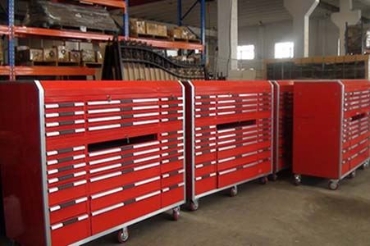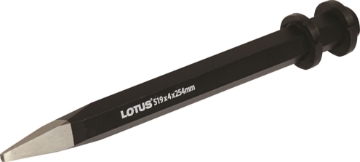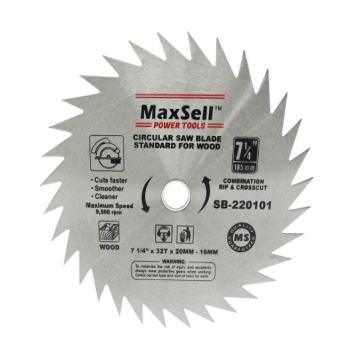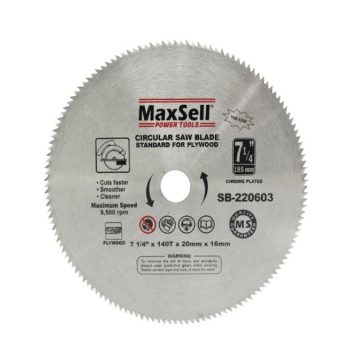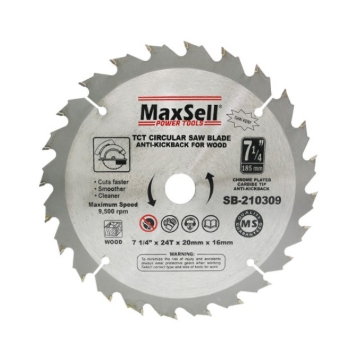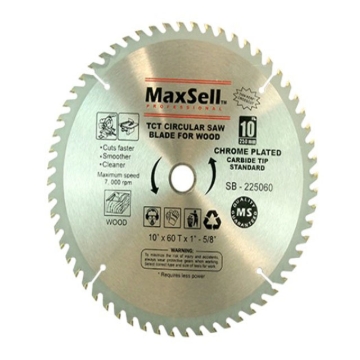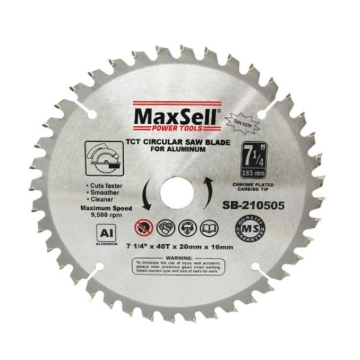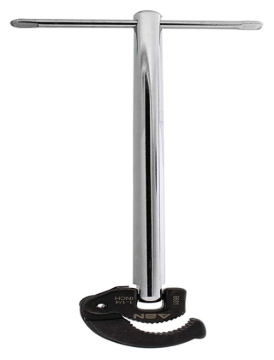Hand Tools
MaxSell Combination of RIP and Cross Cut (Circular Saw Blade), SB-220101
SB-220101
MaxSell Combination of RIP and Cross Cut (Circular Saw Blade)
₱779.00
MaxSell Standard (Circular Saw Blade) for Plywood, SB-220603
SB-220603
MaxSell Standard (Circular Saw Blade) for Plywood
₱820.00
MaxSell TCT-Anti Kickback (Circular Saw Blades), SB-210309
SB-210309
MaxSell TCT-Anti Kickback (Circular Saw Blades)
From ₱699.00
MaxSell TCT-Standard (Circular Saw Blades) for Wood, SB-210040
SB-210040
MaxSell TCT-Standard (Circular Saw Blades) for Wood
From ₱399.00
MaxSell TCT-Standard (Circular Saw Blades), SB-210505
SB-210505
MaxSell TCT-Standard (Circular Saw Blades)
From ₱799.00
Nicholson Circular Saw Carbide Tip for Wood (10" x 30T)
NicSaw
Circular Saw Carbide Tip for Wood (10" x 30T)
From ₱290.00
Nicholson Straight Jaw Locking Plier 219111NB 10"
Straight Jaw Locking Plier 219111NB 10"
From ₱470.00
Nicholson WC34CMN 3/4" Wood Chuck Combination Chisel and Wood Rasp
WC34CMN 3/4" Wood Chuck Combination Chisel and Wood Rasp
From ₱300.00
Ridgid RapidGrip Heavy-Duty Pipe Wrench, 10-inch Pipe Wrench, 10348
10348
Ridgid RapidGrip Heavy-Duty Pipe Wrench, 10-inch Pipe Wrench
From ₱4,600.00
Ridgid Aluminum Straight Pipe Wrench, Plumbing Wrench Silver, Small, 31090
31090
Ridgid Aluminum Straight Pipe Wrench, Plumbing Wrench Silver, Small
From ₱5,600.00
Ridgid Basin Wrench Large Extendable Faucet Installation Tool, Telescoping Plumbers Under Sink Telescopic, 31170
31170
Ridgid Basin Wrench Large Extendable Faucet Installation Tool, Telescoping Plumbers Under Sink Telescopic
From ₱6,300.01
Ridgid Bench Yoke Vise 21A, 1/8-inch to 2-inch Pipe Vise Red, 40080
40080
Ridgid Bench Yoke Vise 21A, 1/8-inch to 2-inch Pipe Vise Red
₱27,800.00
Ridgid Complete 6.35mm (1/4")-25.4mm (1") with 16th Sizes (10 heads with Ratchet & Handle), 36680
36680
Ridgid Complete 6.35mm (1/4")-25.4mm (1") with 16th Sizes (10 heads with Ratchet & Handle)
₱157,700.00
Ridgid Compound Leverage Wrench Heavy-Duty No. S2 (2"), 31375
31375
Ridgid Compound Leverage Wrench Heavy-Duty No. S2 (2")
From ₱56,200.00
Ridgid Heavy-Duty Bolt Cutter with Comfortable Grips and Alloy Steel Jaws, Red, 14213
14213
Ridgid Heavy-Duty Bolt Cutter with Comfortable Grips and Alloy Steel Jaws, Red
From ₱14,400.01
Ridgid Inner Tube Core Barrel Wrench Heavy Duty ,Red , N, 46378
46378
Ridgid Inner Tube Core Barrel Wrench Heavy Duty ,Red , N
₱36,000.00
From ₱25,800.00
Ridgid Internal Wrench No. 342, (1"-2"), Internal Pipe Wrench, Silver, Small, 31405
31405
Ridgid Internal Wrench No. 342, (1"-2"), Internal Pipe Wrench, Silver, Small
₱8,200.00
₱11,600.00
Ridgid Offset Hex Wrench, Model E-110 Hex Pipe Wrench, 1-1/8" - 2 5/8" Capacity, Red, 31305
31305
Ridgid Offset Hex Wrench, Model E-110 Hex Pipe Wrench, 1-1/8" - 2 5/8" Capacity, Red
₱5,300.00
Ridgid RE 60 Electrical Tool
Cat. 47228 RE60
Introducing the world’s most versatile electrical tool. The RE 60 from RIDGID® features our unique QuickChange System™, allowing you to quickly and easily switch between interchangeable heads for cutting, crimping and punching. Now your important tasks can be accomplished with one innovative tool. No more back and forth to the truck, searching for different tools. Whether you’re cutting wire, crimping lugs or punching boxes, the RE 60 helps you maximize your productivity and efficiency on the jobsite.
₱434,000.00
Ridgid Spud Wrench 12-inch Adjustable Spud Wrench: Cast Iron,(3/8"- 2 5/8') in Jaw Capacity, Smooth, 31400
31400
Ridgid Spud Wrench 12-inch Adjustable Spud Wrench: Cast Iron,(3/8"- 2 5/8') in Jaw Capacity, Smooth
₱6,500.00
₱7,500.00
Min:
₱0.00
Max:
₱1,723,800.00
₱0
₱1723800





































































